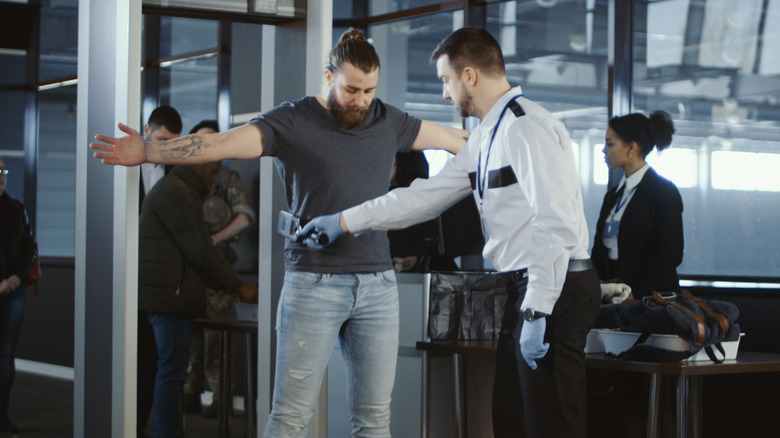Airport security is necessary for air travel, but that doesn’t make it particularly enjoyable. A survey conducted by Priority Pass revealed that going through security checkpoints is one of the most dreaded aspects of airport travel, with nearly 47% of respondents calling the experience stressful. For some people, body scanners only add to the anxiety.
Thankfully, the machines are fairly straightforward: Step inside, place your feet on the floor markings and put your hands above your head. A security agent will usually motion you through, and you’re on your way to your gate. In other cases, though, the scanner may detect an object that requires additional screening — even if you have nothing unusual on your body or in your pockets.
So, what exactly do airport body scanners see, and how do agents decide if you need an additional check? According to the Transportation Security Administration (TSA), the machines detect “concealed items, both metallic and non-metallic, including explosives.” If the scanner recognizes an object, it will identify it using an image of a generic mannequin. This is in contrast to earlier technology, which captured images of passengers’ naked bodies. If no objects are detected, the agent’s screen will give a simple “OK” message, signaling that the traveler is safe to pass through.
How airport body scanners work

Airport body scanners have undergone some changes over the years, but today’s machines rely on electromagnetic millimeter waves. “Essentially, the machines send millimeter waves toward a passenger’s insides,” Dr. Shawna Malvini Redden, a researcher and author of “101 Pat-Downs,” shared with Reader’s Digest. “The waves go through clothing and reflect off the passenger’s skin (and whatever else is concealed) and bounce back an image, which is interpreted by the machine.” However, the scanners can’t detect objects inside the body or buried under the skin.
Still, the imaging technology is quite sensitive and can flag some unexpected items and substances as potential threats. For example, a 2016 case study published in JAMA Dermatology revealed that scanning devices can misinterpret cysts and other skin lesions as foreign objects. Even sweat can set off the machines, as Doug McMakin, the lead researcher who developed the millimeter-wave scanner at the Pacific Northwest National Laboratory, told ProPublica.
Clothing and accessories can sometimes appear on body scanner readings, which is why it’s important to remove jackets, scarves, and other bulky layers when passing through security. Additionally, be sure to limit body jewelry, and be mindful of hidden metal in clothing (such as bra underwires) when entering a TSA security checkpoint.
Can you refuse the use of full-body scanners?

In a 2016 document, TSA argued that airport body scanners are the most effective way to detect threats, surpassing the capabilities of metal detectors and bomb-sniffing dogs. The agency also stated that the technology would have stopped several high-profile security breaches if it had been implemented sooner, including the non-metallic bomb used by the 2009 “Christmas Day bomber” (a passenger who smuggled an explosive device in his underwear). The devices have also been improved to protect passengers’ privacy, bodily integrity, and physical health. Additionally, TSA announced plans in 2022 to revise the body scanners’ gendered screenings to better accommodate the unique needs of transgender and non-binary travelers.
Still, some experts and frequent flyers doubt the safety and accuracy of the machines. If you don’t feel comfortable using airport body scanners, politely request a pat-down instead. Be prepared for the security agent to “physically check your body from head to toe, possibly including an intimate check of breasts/groin/buttocks,” as Dr. Shawna Malvini Redden told Reader’s Digest. Note that TSA may require you to undergo machine body scanning if you’ve been selected for enhanced screening, even if you request to opt-out.

